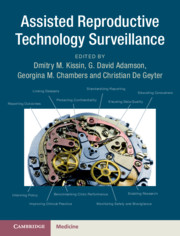Book contents
- Frontmatter
- Contents
- Foreword
- List of Contributors
- Section 1 Introduction to ART Surveillance
- Section 2 General Principles of ART Surveillance
- Section 3 Using ART Surveillance Data
- 5 Reporting ART Success Rates
- 6 Using ART Surveillance Data in Clinical Research
- 7 Monitoring ART Safety and Biovigilance
- 8 Quality Assurance of ART Practice: Using Data to Improve Clinical Care
- 9 Monitoring Long-Term Outcomes of ART: Linking ART Surveillance Data with Other Datasets
- 10 Use of ART Surveillance by People Experiencing Infertility
- Section 4 Global Variations in ART Surveillance
- Section 5 Surveillance of Non-ART Fertility Treatments
- Appendix A ART Surveillance System Variables and Definitions
- Appendix B International Glossary on Infertility and Fertility Care
- Appendix C ICMART Data Collection Form
- Index
- Plates
7 - Monitoring ART Safety and Biovigilance
from Section 3 - Using ART Surveillance Data
Published online by Cambridge University Press: 14 June 2019
- Frontmatter
- Contents
- Foreword
- List of Contributors
- Section 1 Introduction to ART Surveillance
- Section 2 General Principles of ART Surveillance
- Section 3 Using ART Surveillance Data
- 5 Reporting ART Success Rates
- 6 Using ART Surveillance Data in Clinical Research
- 7 Monitoring ART Safety and Biovigilance
- 8 Quality Assurance of ART Practice: Using Data to Improve Clinical Care
- 9 Monitoring Long-Term Outcomes of ART: Linking ART Surveillance Data with Other Datasets
- 10 Use of ART Surveillance by People Experiencing Infertility
- Section 4 Global Variations in ART Surveillance
- Section 5 Surveillance of Non-ART Fertility Treatments
- Appendix A ART Surveillance System Variables and Definitions
- Appendix B International Glossary on Infertility and Fertility Care
- Appendix C ICMART Data Collection Form
- Index
- Plates
Summary
Safety of medical treatments implies all their side and long-term effects on patients. With reference to ART, subjects involved are mothers and their children.Since the early application of IVF, operators have agreed on the importance of monitoring these new techniques in order to build and maintain trust towards them.Collecting data regarding assisted reproduction techniques worldwide is of the utmost usefulness to ensure safety and quality of treatments provided, to detect potential problems, as well as to implement practices aimed at reducing risks and improving outcomes.
Nowadays, well-functioning registries have been set up in most countries. Regulations and guidelines for the monitoring of all clinical and laboratory aspects of assisted reproduction techniques have been issued, also based on data collected so far.
Currently available evidence should be the basis for a further improvement of medical and laboratory practices.
- Type
- Chapter
- Information
- Assisted Reproductive Technology Surveillance , pp. 56 - 68Publisher: Cambridge University PressPrint publication year: 2019
- 1
- Cited by

